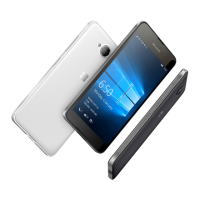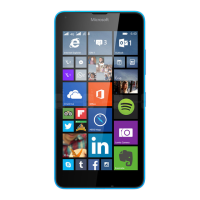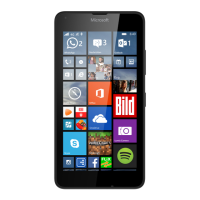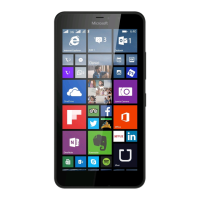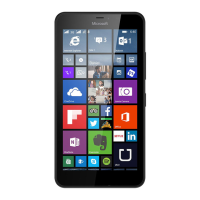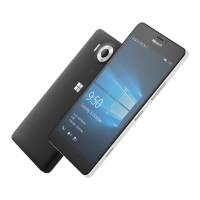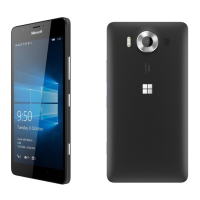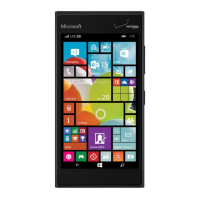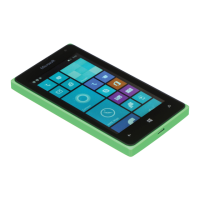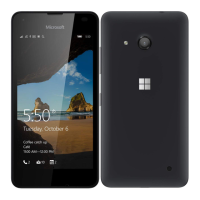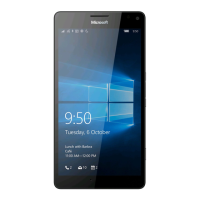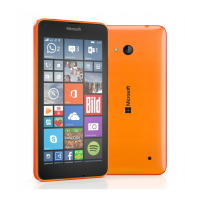Do you have a question about the Microsoft lumia 635 and is the answer not in the manual?
Step-by-step guide for installing SIM and memory cards into the device.
Instructions for turning the phone on and initiating setup.
Procedure for correctly powering down the device.
How to activate the automatic lock feature for security.
Steps to wake up and unlock the phone's screen.
Guide to initial configuration including network and Microsoft account.
Explanation of tap, swipe, and drag interactions on the screen.
Guide to accessing and using the phone's settings interface.
Adjusting ringtone, media, and alarm volume levels.
Activating silent mode to mute all sounds.
Advantages and uses of having a Microsoft account.
Step-by-step guide to setting up a new Microsoft account.
Instructions for signing into an existing Microsoft account.
Customizing background photos, tiles, and layout.
Customizing ringtones and notification sounds.
Steps to configure and personalize the Cortana assistant.
How to use voice commands for various phone functions.
Enabling and using Narrator for voice-guided screen interaction.
Strategies to conserve battery power, including charging and settings.
Input methods including tapping and swipe typing.
Instructions for creating and managing alarms.
Exploring categories and searching for apps and games.
Finding, installing, or purchasing apps, games, and other items.
Instructions for initiating and managing phone calls.
Making calls using voice commands.
Temporarily muting ringing calls.
Procedures for managing contact entries.
Connecting and signing into social networking services.
Configuring and removing email accounts on the phone.
Instructions for capturing still images with the phone camera.
Steps for capturing video footage using the phone's camera.
Performing basic edits like cropping, rotating, and auto-fixing photos.
Obtaining walking, driving, or public transport directions.
Saving maps for offline use without an internet connection.
Understanding how the phone determines location (GPS, Wi-Fi, etc.).
Configuring Wi-Fi and mobile data settings.
Using Bing search to find information online.
Using the phone for media playback and podcast listening.
Instructions for watching video content on the phone.
Tuning into FM radio stations using the phone.
Instructions for playing games on the phone and with Xbox.
Using the Health & Fitness app for personal wellness.
Recording exercise activities and logging food intake.
Getting current and future weather information.
Creating, editing, and sharing Word documents on the go.
Editing spreadsheets and managing data with Excel Mobile.
Creating and presenting PowerPoint files from your phone.
Creating, formatting, and saving notes using OneNote Mobile.
Accessing basic, scientific, and binary calculator functions.
Setting up and utilizing company accounts for work-related access.
Utilizing security options to protect personal data on the phone.
Installing software updates wirelessly for new features and performance.
Setting up and connecting to a Virtual Private Network (VPN).
Creating backups of settings and data, and restoring them.
Configuring the phone to lock itself when not in use.
Locating, locking, or erasing a lost phone remotely.
Essential safety measures for batteries and chargers.
Guidelines for safe mobile phone use while operating a vehicle.
Safety precautions for using the device in hazardous locations.
Step-by-step guide for installing SIM and memory cards into the device.
Instructions for turning the phone on and initiating setup.
Procedure for correctly powering down the device.
How to activate the automatic lock feature for security.
Steps to wake up and unlock the phone's screen.
Guide to initial configuration including network and Microsoft account.
Explanation of tap, swipe, and drag interactions on the screen.
Guide to accessing and using the phone's settings interface.
Adjusting ringtone, media, and alarm volume levels.
Activating silent mode to mute all sounds.
Advantages and uses of having a Microsoft account.
Step-by-step guide to setting up a new Microsoft account.
Instructions for signing into an existing Microsoft account.
Customizing background photos, tiles, and layout.
Customizing ringtones and notification sounds.
Steps to configure and personalize the Cortana assistant.
How to use voice commands for various phone functions.
Enabling and using Narrator for voice-guided screen interaction.
Strategies to conserve battery power, including charging and settings.
Input methods including tapping and swipe typing.
Instructions for creating and managing alarms.
Exploring categories and searching for apps and games.
Finding, installing, or purchasing apps, games, and other items.
Instructions for initiating and managing phone calls.
Making calls using voice commands.
Temporarily muting ringing calls.
Procedures for managing contact entries.
Connecting and signing into social networking services.
Configuring and removing email accounts on the phone.
Instructions for capturing still images with the phone camera.
Steps for capturing video footage using the phone's camera.
Performing basic edits like cropping, rotating, and auto-fixing photos.
Obtaining walking, driving, or public transport directions.
Saving maps for offline use without an internet connection.
Understanding how the phone determines location (GPS, Wi-Fi, etc.).
Configuring Wi-Fi and mobile data settings.
Using Bing search to find information online.
Using the phone for media playback and podcast listening.
Instructions for watching video content on the phone.
Tuning into FM radio stations using the phone.
Instructions for playing games on the phone and with Xbox.
Using the Health & Fitness app for personal wellness.
Recording exercise activities and logging food intake.
Getting current and future weather information.
Creating, editing, and sharing Word documents on the go.
Editing spreadsheets and managing data with Excel Mobile.
Creating and presenting PowerPoint files from your phone.
Creating, formatting, and saving notes using OneNote Mobile.
Accessing basic, scientific, and binary calculator functions.
Setting up and utilizing company accounts for work-related access.
Utilizing security options to protect personal data on the phone.
Installing software updates wirelessly for new features and performance.
Setting up and connecting to a Virtual Private Network (VPN).
Creating backups of settings and data, and restoring them.
Configuring the phone to lock itself when not in use.
Locating, locking, or erasing a lost phone remotely.
Essential safety measures for batteries and chargers.
Guidelines for safe mobile phone use while operating a vehicle.
Safety precautions for using the device in hazardous locations.
| Pixel density | 221 ppi |
|---|---|
| Display diagonal | 4.5 \ |
| Touch technology | Multi-touch |
| Touchscreen type | Capacitive |
| Display resolution | 854 x 480 pixels |
| Display number of colors | 16.78 million colors |
| Maximum video resolution | 1280 x 720 pixels |
| Platform | Windows |
| Operating system installed | Windows Phone 8.1 |
| RAM capacity | 0.5 GB |
| Internal memory | 8 MB |
| Compatible memory cards | MicroSD (TransFlash) |
| Maximum memory card size | 128 GB |
| Internal storage capacity | 8 GB |
| Browsing time | 9.4 h |
| Talk time (2G) | 18.6 h |
| Talk time (3G) | 13 h |
| Battery capacity | 1830 mAh |
| Standby time (2G) | 600 h |
| Standby time (3G) | - h |
| Battery technology | - |
| Continuous audio playback time | 58 h |
| Continuous video playback time | 7 h |
| Form factor | Bar |
| Product color | Green |
| White balance | Auto, Manual |
| Rear camera type | Single camera |
| Rear camera flash | No |
| Maximum frame rate | 30 fps |
| Optical sensor size | 1/4 \ |
| Video recording modes | 720p |
| Rear camera resolution (numeric) | 5 MP |
| Personal info management (PIM) | Alarm clock, Calculator, Calendar, Events reminder, Notes, To-do list |
| Processor cores | 4 |
| Processor family | Qualcomm Snapdragon |
| Processor frequency | 1.2 GHz |
| USB version | 2.0 |
| USB connector type | Micro-USB B |
| HDMI ports quantity | 0 |
| Headphone connectivity | 3.5 mm |
| USB 2.0 ports quantity | 1 |
| 4G standard | LTE |
| 2G standards | GSM |
| 3G standards | WCDMA |
| SIM card type | MicroSIM |
| Wi-Fi standards | 802.11b, 802.11g, Wi-Fi 4 (802.11n) |
| Bluetooth version | 4.0 |
| 3G bands supported | 850, 900, 2100 MHz |
| 4G bands supported | 800, 1800, 2600 MHz |
| Bluetooth profiles | A2DP, AVRCP, GATT, HFP, OPP, PBAP |
| SIM card capability | Single SIM |
| Security algorithms | EAP-AKA, EAP-SIM, EAP-TLS, EAP-TTLS, MSCHAPv2, WEP, WPA, WPA-EAP, WPA-PSK, WPA-TKIP, WPA2, WPA2-AES, WPA2-EAP, WPA2-PSK, WPA2-TKIP |
| 2G bands (primary SIM) | 850, 900, 1800, 1900 MHz |
| Mobile network generation | 4G |
| Audio formats supported | AMR-NB, LC-AAC |
| Video formats supported | AVC, H.264, MP4, MPEG4, VC-1 |
| Multimedia Messaging Service (MMS) | Multimedia Messaging Service (MMS) is a standard way to send messages that include multimedia content to and from a mobile phone over a cellular network |
| Subscription type | No subscription |
| Body SAR (EU) | 0.54 W/kg |
| Head SAR (EU) | 0.71 W/kg |
| Specific absorption rate (SAR) value (EU) | - W/kg |
| Depth | 9.2 mm |
|---|---|
| Width | 66.7 mm |
| Height | 129.5 mm |
| Weight | 134 g |
